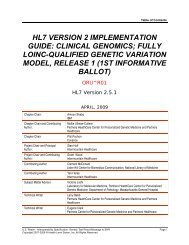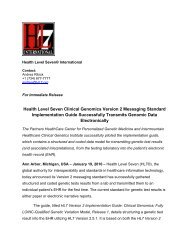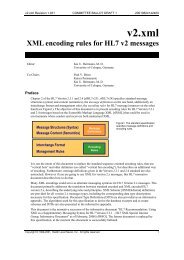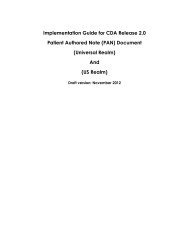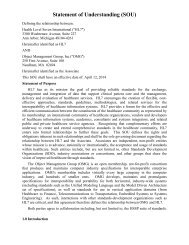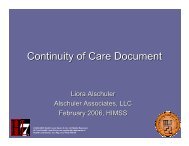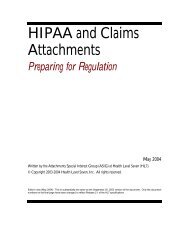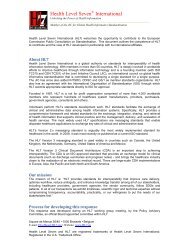HL7 CDA R2 AIS Implementation Guide
HL7 CDA R2 AIS Implementation Guide
HL7 CDA R2 AIS Implementation Guide
You also want an ePaper? Increase the reach of your titles
YUMPU automatically turns print PDFs into web optimized ePapers that Google loves.
<strong>HL7</strong> Additional Information Specification <strong>Implementation</strong> <strong>Guide</strong><strong>CDA</strong><strong>R2</strong><strong>AIS</strong>0000R0305 Response Code SetsAn Additional Information Specification document usually contains all the code tables required tocreate an attachment in the computer decision variant. Due to its length, however, the followingtable is included here and cited in the Additional Information Specification documents.5.1 Unified Code of Units of Measure (UCUM)The Unified Code for Units of Measure (UCUM) is used throughout this implementation guideand <strong>AIS</strong> documents to codify the measurement unit of a physical quantity. Earlier datatransmission standards utilized various units derived from American (ANS, ANS+) orinternational (ISO, ISO+) lists of measurement units.The following list contains those units of measurement likely to be used in attachments. Amapping of UCUM codes to ISO+ codes is included. A complete list of the UCUM values, alongwith supporting documentation and other background, can be obtained from:http://aurora.regenstrief.org/ucumNote the usage of square brackets surrounding several of the UCUM codes. This is explainedmore fully in the UCUM documentation (see above link), and generally indicates multi-wordunits, customary local units, or very rare units. The focus of UCUM is not on a human-readableset of units, and according to the UCUM documentation, if the unit symbols are to be displayedor printed, the square brackets can be removed.<strong>HL7</strong> v3 data types fix any use of UCUM; therefore, an OID does not need to be specified.Table 5.1-1 UCUM code set for units for physical quantities.UCUM Code ISO+ Code Nameg/(kg.d) g/(kg.d) (Gram / Kilogram) / Day = gram / (kilogram × day) (e.g., massdose of medication per body weight per day)g/(kg.h) g/(kg.hr) (Gram / Kilogram) / Hour = gram / (kilogram × hour) (e.g., massdose of medication per body weight per hour)g/(kg.min) g/(kg.min) (Gram / Kilogram) / Minute = gram / (kilogram × minute) (e.g.,mass dose of medication per body weight per minute)g/(8.kg.h) g/(8.kg.hr) (Gram / Kilogram) /8 Hour Shift = gram / (kilogram × 8 hour shift)(e.g., mass dose of medication per body weight per 8 hourshift)ug/(8.h.kg) ug/(8.hr.kg) (Microgram / Kilogram) / 8 hour shift = microgram / (kilogram × 8hour shift) (e.g., mass dose of medication per patient bodyweight per 8 hour shift)ug/(kg.h) ug/(kg.hr) (Microgram / Kilogram) / Hour = microgram / (kilogram × hours)(e.g., mass dose of medication per patient body weight perhour)ug/(kg.min) ug/(kg.min) (Microgram / Kilogram) / Minute = microgram / (kilogram ×minute) (e.g., mass dose of medication per patient bodyweight per minute)ug/(kg.d) ug/(kg.d) (Microgram / Kilogram) /Day = microgram / (kilogram × day) (e.g.,mass dose of medication per patient body weight per day)Copyright © 1998-2007 Health Level Seven, Inc. All rights reserved.Release 3.0 Draft StandardPage 73March 2007




